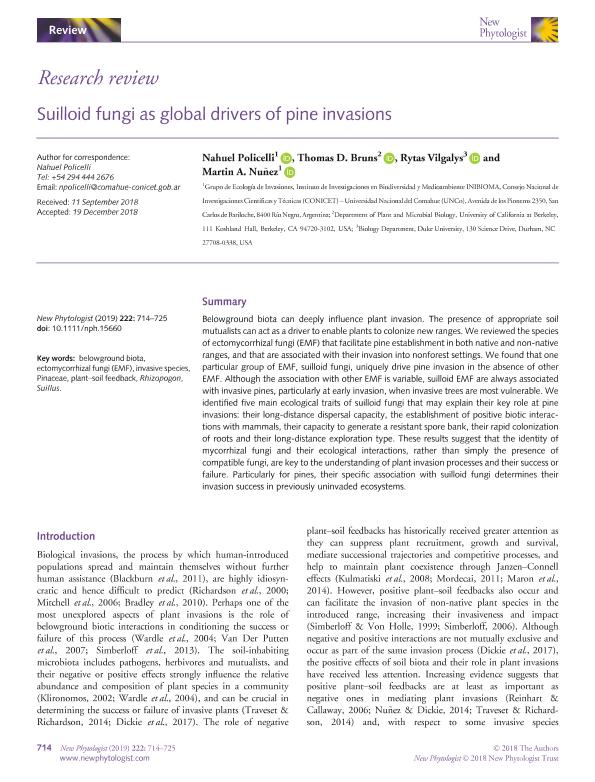Mostrar el registro sencillo del ítem
dc.contributor.author
Policelli, Nahuel

dc.contributor.author
Bruns, Thomas
dc.contributor.author
Vilgalys, Rytas
dc.contributor.author
Nuñez, Martin Andres

dc.date.available
2020-08-21T11:18:52Z
dc.date.issued
2019-01
dc.identifier.citation
Policelli, Nahuel; Bruns, Thomas; Vilgalys, Rytas; Nuñez, Martin Andres; Suilloid fungi as global drivers of pine invasions; Wiley; New Phytologist; 22; 2; 1-2019; 714-725
dc.identifier.issn
0028-646X
dc.identifier.uri
http://hdl.handle.net/11336/112104
dc.description.abstract
Belowground biota can deeply influence plant invasion. The presence of proper soil mutualists can act as a driver that enable plants to colonize new ranges. We review the species of ectomycorrhizal fungi (EMF) that facilitate pine establishment in both native and non-native ranges and that are associated with their invasion into nonforest settings. We found that one particular group of EMF, suilloid fungi, uniquely drive pine invasion in the absence of other EMF. While the association with other EMF is variable, suilloid EMF are always associated with invasive pines, particularly at early invasion, when invasive trees are most vulnerable. We identified five main ecological traits of suilloid fungi that may explain their key role at pines invasion: their long distance dispersal capacity, the establishment of positive biotic interactions with mammals, their capacity to generate a resistant spore bank, their rapid colonization of roots, and their long distance exploration type. These results suggest that the identity of mycorrhizal fungi, and their ecological interactions, rather than simply the presence of compatible fungi, are key to understanding plant invasion processes and their success or failure. Particularly for pines, their specific association with suilloid fungi determines their invasion success in previously uninvaded ecosystems.
dc.format
application/pdf
dc.language.iso
eng
dc.publisher
Wiley

dc.rights
info:eu-repo/semantics/openAccess
dc.rights.uri
https://creativecommons.org/licenses/by-nc-sa/2.5/ar/
dc.subject
BELOWGROUND BIOTA
dc.subject
ECTOMYCORRHIZAL FUNGI
dc.subject
INVASIVE SPECIES
dc.subject
PLANT SOIL FEEDBACK
dc.subject.classification
Ecología

dc.subject.classification
Ciencias Biológicas

dc.subject.classification
CIENCIAS NATURALES Y EXACTAS

dc.title
Suilloid fungi as global drivers of pine invasions
dc.type
info:eu-repo/semantics/article
dc.type
info:ar-repo/semantics/artículo
dc.type
info:eu-repo/semantics/publishedVersion
dc.date.updated
2020-07-21T21:02:42Z
dc.identifier.eissn
1469-8137
dc.journal.volume
22
dc.journal.number
2
dc.journal.pagination
714-725
dc.journal.pais
Estados Unidos

dc.journal.ciudad
Hoboken
dc.description.fil
Fil: Policelli, Nahuel. Consejo Nacional de Investigaciones Científicas y Técnicas. Centro Científico Tecnológico Conicet - Patagonia Norte. Instituto de Investigaciones en Biodiversidad y Medioambiente. Universidad Nacional del Comahue. Centro Regional Universidad Bariloche. Instituto de Investigaciones en Biodiversidad y Medioambiente; Argentina
dc.description.fil
Fil: Bruns, Thomas. University of California at Berkeley; Estados Unidos
dc.description.fil
Fil: Vilgalys, Rytas. University of Duke; Estados Unidos
dc.description.fil
Fil: Nuñez, Martin Andres. Consejo Nacional de Investigaciones Científicas y Técnicas. Centro Científico Tecnológico Conicet - Patagonia Norte. Instituto de Investigaciones en Biodiversidad y Medioambiente. Universidad Nacional del Comahue. Centro Regional Universidad Bariloche. Instituto de Investigaciones en Biodiversidad y Medioambiente; Argentina
dc.journal.title
New Phytologist

dc.relation.alternativeid
info:eu-repo/semantics/altIdentifier/url/https://nph.onlinelibrary.wiley.com/doi/full/10.1111/nph.15660
dc.relation.alternativeid
info:eu-repo/semantics/altIdentifier/doi/http://dx.doi.org/10.1111/nph.15660
Archivos asociados
